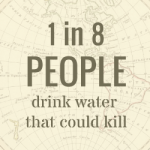THE NEED
————— a silent emergency —————
There is more than enough fresh water
in the world for domestic use, agriculture and industry, however, the
poor are largely excluded from this globally recognized “human right.”
The millions forced to collect water from drains, ditches and streams
suffer a deprivation that threatens life, destroys opportunity and
severely undermines human dignity. This is the problem, and it can all
be avoided.
.
A global issue 
Across much of the developing world, “unclean water is an immensely greater threat to human security than violent conflict”1.
Sadly, children’s vulnerability makes them the greatest bearers of this
tragedy. Each year an estimated 2.2 million children die from diarrhea2 and 443 million school days are lost to water-related illnesses1.
Most notably this crisis could be prevented by the provision of three
fundamental foundations of human progress: delivering clean water,
removing waste water and providing sanitation.
Tthe African burden
Rural peoples harbor the majority of
this cruel, subtle crisis. The African continent faces the greatest
challenge of any region of the world with roughly 1 of 3 (330 million)
people not using a clean water source. Eighty-four percent of these
people live in rural areas. This represents an increase of 66 million
people since 19905 who do not have a clean water source.
Unfortunately, aid commitments for solutions targeting rural populations
are declining while aid for urban solutions has increased 60% since
20006. As a result, on any given day more than 50% of
hospital beds in Sub-Saharan Africa are filled with water/hygiene
related illnesses6.
Women and girls
In rural
settings it is traditionally women and young girls who bear the
responsibility of obtaining their family’s water supply. In Sub-Saharan
Africa, 68% of the rural population spends more than 1 hour per trip of
water collection3. That means valuable time, sometimes
upwards of 3 hours a day, is lost collecting insufficient, contaminated
water. Ultimately, a woman’s opportunity in education or small business
ventures are entirely inhibited with this strenuous work.
.
Holistic development
The solution,
while surprisingly straightforward, is critical for developmental
progress. When implemented—the comprehensive approach of providing
water, sanitation and hygiene together—has profound impact on the
communities involved. In-terms of direct economic reward, every dollar
invested in water and sanitation yields a $9 return7. While the UN suggests that a person’s basic needs can be met with a mere 20-50 litres (4-10 gal) of safe water8, WWFA is committed to establishing and maintaining a holistic and integrated approach. The impact is one for life.
- United Nations Develop Program (UNDP), Human Development Report 2006; Beyond scarcity: Power, poverty and the global water crisis
- WHO, UN Water GLASS 2010 Report
- (JMP) Progress on Sanitation and Drinking-Water: 2010 Update
- Water Supply and Sanitation Collaborative Council (WSSCC)
- A Snapshot of Drinking-water and Sanitation in the MDG region sub-Saharan Africa – 2010 Update (August 2010)
- Drinking Water Equity, Safety and Sustainability: Thematic report on drinking water 2011
- United Nations Development Program (UNDP)
- World Water Assessment Programme (WWAP)

No comments:
Post a Comment